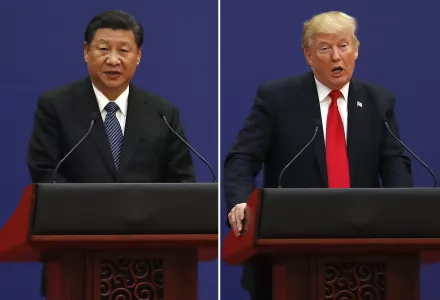
Mike Pence says Beijing has been fighting for years and that America will respond
In an under-noticed speech last week, US vice-president Mike Pence delivered a de facto declaration of cold war against China. As a candidate, Donald Trump complained that China was “raping” America. After months of smaller steps, his administration has now pledged to fight back hard on all fronts — and win.
Mr Pence’s big idea is that US presidents Bill Clinton, George W Bush and Barack Obama fundamentally misunderstood the China challenge. The nation they embraced as a “strategic partner” is in fact a “strategic competitor”, “rival”, indeed “adversary”. Previous administrations made a cosmic bet. They wagered that integrating China into the US-led international order would lead it to develop a normal free market economy, democracy, the rule of law guaranteeing human rights, and acceptance of its place as a “responsible stakeholder”. They lost that bet — and the Trump administration is left to deal with the consequences.
Accusing previous administrations of having ignored or even “abetted” China’s abuses, Mr Pence insisted that Team Trump will speak up, stand up, fight, and win. As Mr Trump said in August: “When I came we were heading in a certain direction that was going to allow China to be bigger than us in a very short period of time. That’s not going to happen any more.”
If this were simply a matter of rhetoric, or the trash talk of campaigns, it could be discounted. Instead, the approach reflects a serious emerging strategy to confront China. The outlines of this clash are unfolding piecemeal, without the benefit of core strategic documents like George Kennan’s Long Telegram or Paul Nitze’s NSC-68 policy paper that crystallised US strategy in the first cold war. But it is informed by a considered diagnosis of China’s ambitions and actions during recent decades.
According to the Trumpists, the cold war between Washington and Beijing isn’t new. China has been fighting the US for decades. What is new is that Washington has responded. As secretary of state Mike Pompeo put it: “The trade war by China against the US has been going on for years. Here’s what’s different in this administration . . . we are determined to win it.”
“The central challenge to US prosperity and security”, this administration argues in its national defence strategy paper, are two “revisionist powers” — China and Russia. They, the administration says, are trying to “shape a world antithetical to US values and interests”. China is conducting a “whole of government” assault on the US by every means short of bombs and bullets.
The most radioactive strand in Mr Pence’s speech is his charge that China is seeking to “interfere in the domestic policies of this country” and influence next month’s midterm elections. If the Democrats take the House of Representatives in November, they will probably begin impeachment hearings that could distract Mr Trump and his team.
Mr Pence says China’s comprehensive “influence operation” is “rewarding or coercing” American businesses, movie studios, universities, think-tanks, journalists, and government officials and targeting activities in specific congressional districts. Mr Pence concludes that “what the Russians are doing pales in comparison to what China is doing”.
The Trump administration’s new strategic thrust is more aspirational than operational. But its tariffs on $250bn-worth of Chinese imports, tightening of rules on Chinese investments in the US, screening of supply chains for national security vulnerabilities, and boost of military spending by $82bn are indicators of what is to come.
Strategy requires an alignment of ends, ways, and means. At this point, the administration is longer on ways than the other two. Is wholesale confrontation of China feasible? Measured by purchasing power parity (the IMF’s preferred yardstick for comparisons), China’s economy is already larger than America’s. It is the top trading partner of all major Asian countries. It has also been the undisputed growth engine of the world since the 2008 crisis. Can the US create a correlation of forces that can tame this China? If the US leads, who will follow? Allies such as Australia and Japan have told their US counterparts: don’t make us choose between our economic relationship with China and our security relationship with you.
A high-level Chinese official told me this week that his country is “flummoxed” by the Pence speech. The possibility of a new cold war has sent Chinese strategists back to reading the ancient Greek historian Thucydides. He argued the origins of the Peloponnesian war lay in the “fear” the rise of Athens instilled in nearby Sparta.
China’s rise is unquestionably encroaching on America’s accustomed position. But viewing these developments through the lens of US domestic politics invites gross misperceptions. The Chinese rightly worry about the systemic risks inherent in this dangerous dynamic. It leaves both countries vulnerable to third-party provocations — like the assassination of an archduke in June 1914.
We should be worried, too.
Allison, Graham. “The U.S. is Hunkering Down for a New Cold War With China.” Financial Times, October 12, 2018




